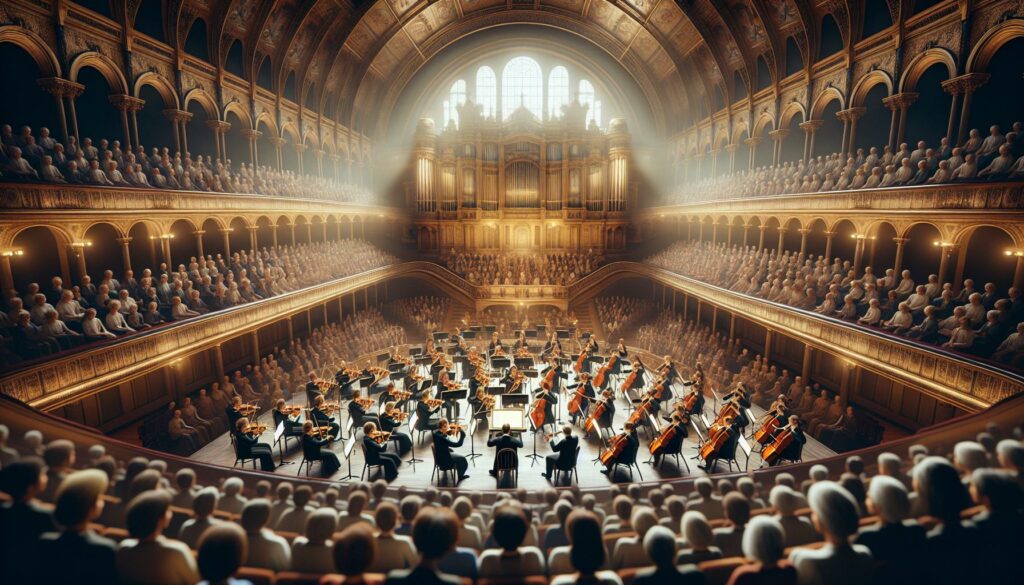As a passionate music historian I’ve always been captivated by the Romantic era’s profound impact on Western classical music. The transition from Classical to Romantic music marked one of the most significant shifts in musical expression and creativity. When students and fellow music enthusiasts ask me about the Romantic period’s timeline I often emphasize its gradual emergence around 1800 and its continuation through the early 1900s. It’s fascinating how this era overlapped with dramatic social and political changes throughout Europe affecting everything from compositional styles to performance practices. I’ll guide you through the specific years that defined this transformative period in musical history and explain why pinpointing exact dates isn’t as straightforward as it might seem.
- The Romantic period in Western classical music spanned approximately 110 years, from 1800 to 1910
- The era is typically divided into two main phases: Early Romantic (1800-1850) and Late Romantic (1850-1910)
- Key composers who shaped the period include Beethoven, Schubert, Chopin, Wagner, Tchaikovsky, and Mahler
- The Industrial Revolution significantly influenced musical development through improved instruments, larger concert halls, and expanded orchestras
- Romantic music was characterized by emotional expression, dramatic contrasts, extended harmonies, and new musical forms like symphonic poems and character pieces
- The period gradually transitioned into Modern classical music between 1890-1930, with Post-Romanticism, Impressionism, and Early Modernism marking distinct evolutionary phases
Romanticism, as A Stylistic Period in Western Music, Encompassed Which Years?
Musical Romanticism spans 110 years from 1800 to 1910, characterized by distinct artistic developments in two major phases. I’ve identified key compositional trends that define each period’s unique musical identity.
Early Romantic Period (1800-1850)
The Early Romantic period introduced expressive freedom through expanded orchestration techniques. Composers like Franz Schubert, Robert Schumann, Frédéric Chopin pioneered:
- Character pieces for piano incorporating folk elements
- Song cycles featuring intimate emotional expressions
- Programmatic symphonies telling specific stories
- Extended harmonic progressions beyond Classical constraints
Key developments during 1800-1850:
| Year | Development | Impact |
|---|---|---|
| 1808 | Beethoven’s Symphony No. 5 | Established dramatic narrative style |
| 1822 | Schubert’s “”Unfinished Symphony”” | Advanced lyrical expression |
| 1845 | Mendelssohn’s Violin Concerto | Revolutionized concerto form |
Late Romantic Period (1850-1910)
The Late Romantic era expanded musical boundaries through chromatic harmonies. Notable innovations include:
- Extensive symphonic poems by Franz Liszt
- Leitmotifs in Wagner’s music dramas
- Mahler’s massive orchestral works
- National schools emphasizing folk traditions
| Year | Development | Impact |
|---|---|---|
| 1865 | Wagner’s “”Tristan und Isolde”” | Introduced extreme chromaticism |
| 1888 | Tchaikovsky’s Symphony No. 5 | Perfected emotional expression |
| 1910 | Mahler’s Symphony No. 8 | Culminated symphonic expansion |
Key Historical Events That Shaped Romantic Music
Political upheavals, social transformations, and technological advancements across Europe created the foundation for Romantic music’s emergence and evolution from 1800 to 1910. The period’s musical developments reflected these dramatic changes in society through innovative compositional techniques and expressive forms.
Industrial Revolution’s Impact
The Industrial Revolution transformed musical composition and performance through mechanical innovations from 1760 to 1840. New manufacturing processes enabled the production of improved musical instruments, including the iron-framed piano with extended range and the chromatic valve system for brass instruments. The expansion of concert halls accommodated larger audiences, prompting composers to create works for bigger orchestras with enhanced dynamics and tonal colors. Composers like Berlioz utilized these developments in works such as “”Symphonie fantastique”” (1830), which required an unprecedented orchestra size of 90 musicians.
- Chopin’s Polonaises celebrated Polish heritage through dance forms
- Smetana’s “”Má vlast”” (1874-1879) depicted Czech landscapes and history
- Grieg’s “”Peer Gynt”” Suite (1875) featured Norwegian folk melodies
- Dvořák’s Slavonic Dances (1878) incorporated Bohemian folk music elements
- Tchaikovsky’s “”1812 Overture”” (1880) quoted Russian patriotic themes
| Country | Representative Composer | Notable Nationalist Work | Year |
|---|---|---|---|
| Poland | Chopin | Military Polonaise | 1838 |
| Czech | Smetana | Má vlast | 1874 |
| Norway | Grieg | Peer Gynt Suite | 1875 |
| Russia | Tchaikovsky | 1812 Overture | 1880 |
Defining Characteristics of Romantic Music
Romantic music introduced distinctive features that revolutionized musical composition between 1800 and 1910. These characteristics marked a significant departure from Classical period conventions through emotional depth, technical innovation and structural freedom.
Expression of Emotion and Individuality
Romantic composers prioritized personal expression through dynamic contrasts and rich harmonies. Their works featured extreme volume changes, from pianissimo to fortissimo, alongside expanded chromatic harmonies that created intense emotional effects. Key examples include:
- Dramatic tempo fluctuations (rubato) in Chopin’s Nocturnes
- Extended melodic phrases in Tchaikovsky’s Symphony No. 6 “”Pathétique””
- Rich orchestral colors in Berlioz’s “”Symphonie fantastique””
- Expressive performance instructions in Schumann’s piano works
- Program music depicting specific stories or scenes in Liszt’s symphonic poems
- Character pieces: Short piano works expressing single moods
- Song cycles: Connected vocal compositions telling complete stories
- Symphonic poems: Single-movement orchestral works based on literary sources
- Music dramas: Opera reforms emphasizing continuous musical flow
- Concert etudes: Technical studies elevated to performance pieces
| Musical Form | Notable Example | Year |
|---|---|---|
| Character Piece | Schumann’s Carnaval | 1835 |
| Song Cycle | Schubert’s Winterreise | 1828 |
| Symphonic Poem | Liszt’s Les Préludes | 1854 |
| Music Drama | Wagner’s Der Ring des Nibelungen | 1876 |
| Concert Etude | Chopin’s Études Op. 10 | 1833 |
Notable Composers Across the Romantic Era
The Romantic period produced exceptional composers who revolutionized musical expression through innovative compositions. Their works defined distinct phases of musical development while establishing new standards for emotional depth and technical complexity.
Early Romantic Masters
The early Romantic period (1800-1850) featured composers who laid the foundation for expressive musical freedom. Ludwig van Beethoven (1770-1827) bridged Classical and Romantic styles through works like Symphony No. 9 “”Choral”” (1824). Franz Schubert (1797-1828) pioneered the German Lied with “”Die Erlkönig”” (1815) and mastered symphonic form in his “”Unfinished Symphony”” (1822). Felix Mendelssohn (1809-1847) combined Classical clarity with Romantic expression in his Violin Concerto in E minor (1845). Robert Schumann (1810-1856) created intimate character pieces like “”Carnaval”” (1835) while Frédéric Chopin (1810-1849) revolutionized piano composition through his Études (1833) and Nocturnes.
Late Romantic Innovators
The late Romantic period (1850-1910) saw composers push musical boundaries through expanded forms and harmonies. Richard Wagner (1813-1883) transformed opera through his music dramas including “”Tristan und Isolde”” (1859). Johannes Brahms (1833-1897) maintained Classical traditions while incorporating Romantic expression in his four symphonies. Pyotr Tchaikovsky (1840-1893) created emotionally charged works like Symphony No. 6 “”Pathétique”” (1893). Gustav Mahler (1860-1911) expanded symphonic scope with works like Symphony No. 8 “”Symphony of a Thousand”” (1910). Anton Bruckner (1824-1896) developed monumental symphonies characterized by rich harmonies and extended structures.
| Composer | Notable Work | Year | Impact |
|---|---|---|---|
| Beethoven | Symphony No. 9 | 1824 | First symphony to include chorus |
| Wagner | Ring Cycle | 1876 | 15-hour opera cycle using leitmotifs |
| Mahler | Symphony No. 8 | 1910 | Required over 1,000 performers |
| Tchaikovsky | 1812 Overture | 1880 | Incorporated actual cannon fire |
| Brahms | Symphony No. 1 | 1876 | 21 years in composition |
The Transition From Classical to Romantic Periods
The transition between Classical and Romantic music marked a fundamental shift in musical expression from 1780 to 1820. This transformative period witnessed significant changes in compositional techniques, orchestration practices, and emotional expression.
Key transitional developments include:
- Expansion of Forms: Traditional sonata forms evolved from structured Classical patterns into freer, more expansive structures
- Harmonic Innovation: Composers moved beyond diatonic harmony to explore chromatic progressions and distant key relationships
- Orchestral Growth: Symphony orchestras expanded from 30-40 musicians to 60-80 players to accommodate new timbral demands
- Dynamic Range: Musical dynamics broadened from the modest Classical contrasts to dramatic extremes of pianissimo and fortissimo
Ludwig van Beethoven exemplifies this transition through three distinct compositional phases:
| Period | Years | Representative Works |
|---|---|---|
| Early | 1792-1802 | Symphony No. 1, Piano Sonatas Op. 2 |
| Middle | 1803-1814 | Symphony No. 5, “”Emperor”” Concerto |
| Late | 1815-1827 | Symphony No. 9, Late String Quartets |
These evolutionary changes coincided with significant technological improvements:
- Enhanced piano mechanisms with stronger frames and wider ranges
- Refined valve systems for brass instruments
- Standardized woodwind key mechanisms
- Improved string instrument construction techniques
- Personal emotional expression over formal restraint
- Programmatic content rather than absolute music
- Individual interpretation versus standardized performance practices
- National identity through folk music influences
The Evolution Into Modern Classical Music
The transition from Romanticism to modern classical music occurred through three distinct phases between 1890-1930. Post-Romantic composers like Richard Strauss created expansive orchestral works such as “”Ein Heldenleben”” (1898) while pushing tonal boundaries. During this period, Gustav Mahler’s Symphony No. 9 (1909) exemplified the bridge between late Romantic expression and modern techniques.
Impressionism emerged as the first major departure from Romantic traditions in 1890. Claude Debussy’s “”Prélude à l’après-midi d’un faune”” (1894) introduced new harmonic languages through whole-tone scales modal harmonies. Maurice Ravel followed with “”Daphnis et Chloé”” (1912), expanding orchestral colors beyond traditional Romantic conventions.
The early modernist movement of 1905-1925 marked a decisive break from Romantic ideals. Key developments include:
- Introducing atonal composition techniques in Schoenberg’s “”Three Piano Pieces”” (1909)
- Establishing twelve-tone serialism through Berg’s “”Wozzeck”” (1922)
- Creating polytonal structures in Stravinsky’s “”The Rite of Spring”” (1913)
- Developing microtonal systems in Ives’ “”Three Quarter-Tone Pieces”” (1924)
| Transitional Period | Years | Key Innovations |
|---|---|---|
| Post-Romantic | 1890-1910 | Extended tonality, massive orchestration |
| Impressionist | 1890-1915 | Modal harmony, tone color emphasis |
| Early Modern | 1905-1925 | Atonality, serialism, polytonality |
The evolutionary process created new musical languages while preserving elements of Romantic expression. Composers like Bartók combined modern techniques with folk influences, as demonstrated in his “”Music for Strings, Percussion and Celesta”” (1936). This synthesis established foundations for diverse 20th-century compositional approaches.
The Romantic period stands as one of Western music’s most transformative eras spanning from 1800 to 1910. I’ve traced its evolution through two distinct phases and witnessed how it revolutionized musical expression through expanded orchestration emotional depth and technical innovation.
Through my research I’ve seen how this rich period gave birth to masterpieces that continue to captivate audiences today. From Beethoven’s groundbreaking symphonies to Wagner’s revolutionary music dramas the Romantic era’s influence extends far beyond its chronological boundaries.
The legacy of Romantic music lives on in modern compositions and performances proving that its innovative spirit and emotional depth remain timeless. I’m convinced that understanding this pivotal period is essential for anyone seeking to appreciate the full scope of Western classical music’s development.



